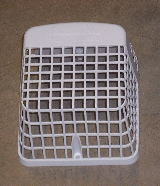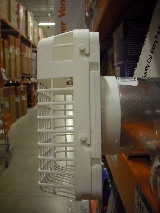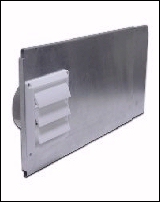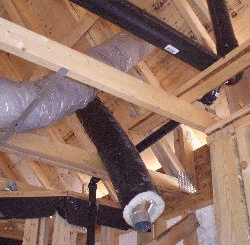| Dryer vent hoods. Pest guards |

Pest guard. Can be removed
for vent cleaning |
 Guard can not be removed
Guard can not be removed
No one-way flap to keep out cold
|

Removable pest guard
Louvres will keep out the cold
|
 Galvanized steel insert
Galvanized steel insert
for window venting
|
 Gooseneck vent for roof venting
Gooseneck vent for roof venting |
 Birds can be pretty persistant
Birds can be pretty persistant
when choosing a new home |
|
Clothes Dryer Vent Hoods
for wall, window and roof venting |
|
|
Dryer vent hoods. Pest guards
PURPOSE OF A DRYER VENT HOOD
- To vent the moist warm air from the clothes dryer to the outside.
- To prevent cold air from entering the vent and laundry room.
- To prevent pests and bird from entering the dryer vent.
DO NOT USE A SCREENED VENT HOOD
Yes, I know, all major home improvement centres sell screened dryer vent hoods but that doesn't mean they are OK to use. If lint has made it all the way from the dryer to the exterior vent hood, don't trap it in with a screen, just let it escape. The screen will get clogged in no time by lint residue which could lead to overheating of lint and/or dryer and cause a fire, see USFA documentation below.
KEEP BIRDS AND CRITTERS OUT
Over the years I discovered countless bird nests built right into the clothes dryer vent where it exits the house. Especially the older single flap dryer hood vents were easy for birds to get in and believe it or not, these vent hoods can still be bought. If there is a single flap dryer vent hood at your home you may want to consider installed a pest guard which not only will keep out birds but also mice and chipmunks. Another option to outsmart the birds is to install a vent that has small louvers rather than a single large flap. These can't be entered by birds because openings are too small. |
 Insulated bathroom and clothes dryer vents.
Insulated bathroom and clothes dryer vents.
The insulation
will
prevent the warm air in the vent
from condensing and
freezing up during the cold
winter months which could
lead to a partial
or complete blocked vent.
|
|
BAD AND GOOD DRYER VENT HOODS
Bad choices:
- Hood with one-way flap, no screen. Birds and pests can get in easy.
- Hood with wire mesh screen. Dryer vent will clog up in no time. Needs constant cleaning, IF you can get at it.
- Louvered vent hood, no pest guard. Unwanted guests still can get in. I have seen scores of broken louvers, courtesy of persist ant birds.
- Any vent hood that has a fixed pest guard or fixed louvres. It is impossible to vacuum the venting system from the exterior.
Good choices:
- Any screenless vent hood with removable pest guard and one-way flap or louvres. These vents let lint get out and stop pests from getting in. By removing the guard it is easy to clean the venting system by inserting a vacuum hose or lint removal extension hose. The one-way flap or louvres will keep the cold out of the dryer vent, dryer and laundry room.
DRYER VENTING THROUGH ATTIC & ROOF
Clothes dryer vents can be vented straight up through the attic. The hot air will rise just about on its own. Keeping the exhaust vent as short as possible will help. It is important to insulate the dryer vent where it passes through the attic. The insulation will prevent the warm air in the vent from condensing and freezing up during the cold winter months which could lead to a partial or complete blocked vent.
WARNING. If the dryer vent is vented through a standard roof vent check from time to time to make sure it is still properly connected. More than once have I seen disconnected dryer vents laying on the attic insulation or dangling from a roof truss. Escaping warm moist air into the attic WILL lead to mold problems and structural damage. Read more about eliminating other moisture problems in the home.
DRYER VENTING THROUGH WINDOW
Venting through an exterior wall is not always practical or just too expensive. The easiest way would be to open a window and let the vent hose dangle outside and take it back in again after the dryer is finished. Believe me, I have seen this more than once! This method compromises the home's security so, do not dry a load of laundry while away from home.
For a more permanent window hookup you can remove a window pane and replace it with galvanized sheet metal that has 4 inch (10 cm) cut-out for inserting the clothes dryer vent hood.
SUMMARY.
THE PERFECT CLOTHES DRYER VENT HOOD HAS:
- no wiremess screen (which WILL clog up the vent).
- a removable pest guard (so vent can be vacuumed from the outside).
- a one-way flap or louvres to keep cold air from entering the dryer and laundry room. |
USFA DOCUMENTED CLOTHES DRYER FIRES
The United States Fire Administration (USFA) has released a report stating that clothes dryer fires account for an estimated 12,700 residential fires, 15 deaths and 400 injuries annually. The USFA attributes “Failure to clean” as the leading factor contributing to clothes dryer fires in residential buildings.
WARNING
Venting a clothes dryer indoors may help in keeping heating costs down during the winter months but could lead to health problems and structural damage. |
|
|
|
|
|
Back to Top |
|